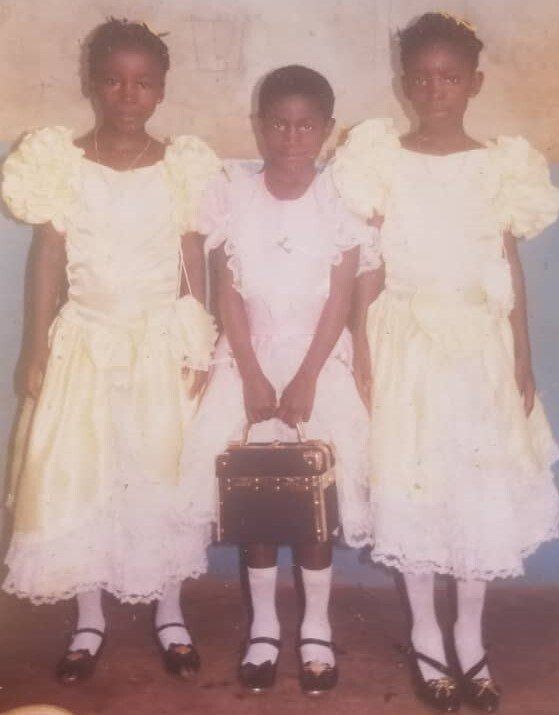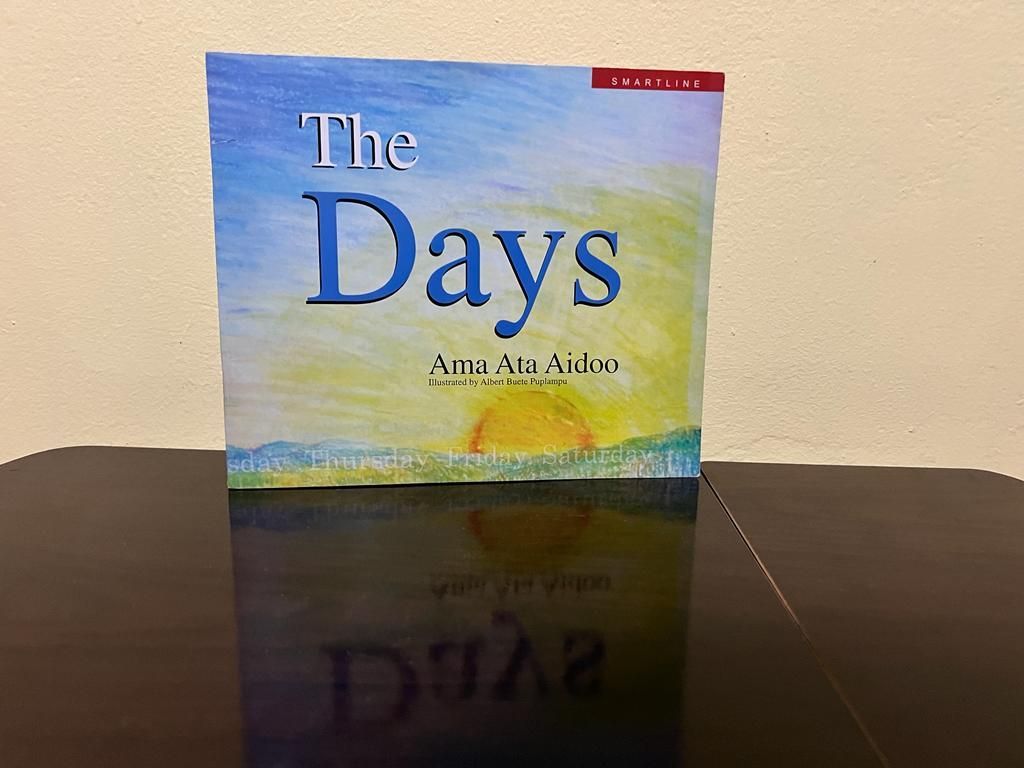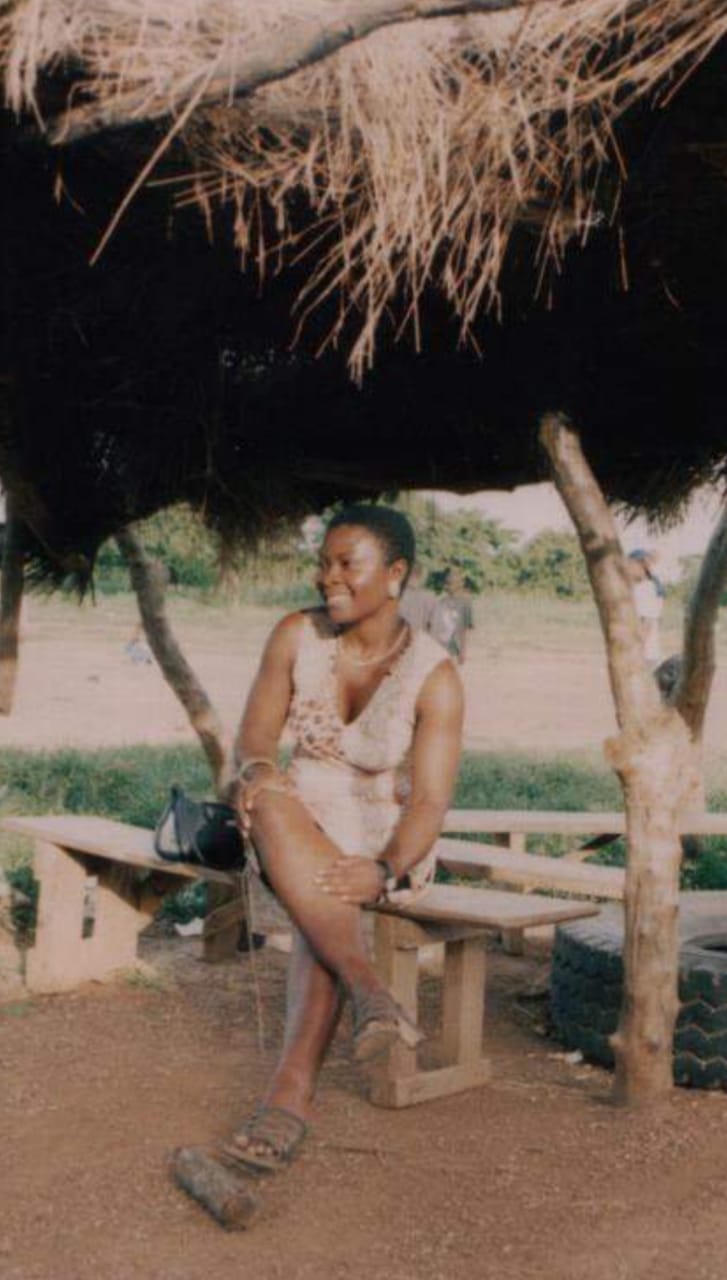Bomaa Bronya
Esi Arhin • December 20, 2020
Recollections of Christmases Past

Afia Bremponaa Hinneh, second from left with her older twin sisters circa 1993/94.
For a reason I cannot put my finger on, this Christmas has become particularly important to me. Perhaps it is that the year 2020 has brought so much negative anxiety. For years, since I became a mother, I've gone through the festivities of the Christmas season just for my children. I had entirely lost interest in Christmas until my childhood memories were recently evoked, reigniting my interest in the season and the joy and genuine goodwill it brings.
I find myself in the spirit and looking forward to Christmas day as much as I used to as a child growing up in the military barracks on an apartment block full of so many other children, one of whom is William Kwame Asiedu, managing editor of EIB Network. His handsome older brother, Mike and I, got on famously. He was the DJ of the block. Mike would play music and gather the kids for a dance competition periodically. The height of the competition was during the Christmas festivities. Back then William, Kwame I call him was a great dancer; he had moves!
We lived.
Lately I've taken to asking people how they spent their Christmas holidays as children and what it meant for them. My enquiry got Afia Brempomaa Hinneh showing me some photos of herself as a child all decked out in her Bronya dress ready to go "Afehyia pa-ing", visiting friends and family to wish them the best of the season and the coming year.
The traditional afehyia pa tour is a kind of well-wishing affirmations spread around to turn fortunes round for the better for everyone. Afia, who comes from Bomaa, a small town in the Tano North District of Ahafo Region where she also grew up, told me Christmas was the highlight of the year for which the entire town anxiously looked forward to and prepared for.
Preparation towards Christmas begin as early as December 10th for the people of Bomaa. Afia recounts how Christmas festivities proceeded.
“We gather firewood, harvest food from the farm left purposely for use during the Christmas season. It was during this period that some of the best crops were preserved for harvesting.
By December 20th, the families get much busier where every member was required to go to the farm to help out. One of the main duties was to bring home ‘ Bronya Aduane'; farm produce for the celebration of Christmas – cassava, yam, plantain, cocoyam, vegetables and fruits in large quantities. Even children as young as three were given something small to carry home from the farm. Stocking up on firewood was most important as lots of cooking is done during this period.
On 24th December, every member of the family will go to the farm for the last time of the year to bring home their “Bronya Dua” Christmas tree. This is not the "conventional" Christmas tree you may be thinking of.
The Christmas tree we bring home are crops that can be planted to bear fruit. I preferred the plantain sucker and always went for that. Immediately after returning home from the farm, everyone scrambled to find just the perfect spot on the compound to plant their christmas tree. It was each individual’s responsibility to water and look after their tree to ensure it flourishes through the year. If the trees grow, it is a sign of good things to come.
Christmas eve was no time for sleeping. I imposed upon myself a kind of wake keeping. I would toss and turn on my mat going over and over in my mind how my "Bronya ataadi3", Christmas dress, would look on me. I was way too anxious for Christmas to arrive that sleep would often not come until much later, deep into the night.
On the 25th December, alas Christmas day, everyone was up at the crow of the cock!. Sounds of neighbours wishing each other Afehyiapa can be heard from nearby homes.
We take our baths early, take our mini special breakfast and set off to church. Christmas church service was special, the church windows were decorated with wreathes woven from palm branches intertwined with colourful flowers of all kinds. There was lots of singing, dancing and hand shaking. Some handshakes were so vigorous that one may actually feel a slight jolt of pain in the upper joint of his or her arm.
The adults hurry home after Christmas service to light the kitchen fires in preparation for the evening meal.
After dinner, nice and full, we take our evening baths and settle down for storytelling. Most of the stories were mainly fables with some, downright spooky. We would break out in song, call and response and make merry by the dim lit fire until bedtime.
Christmas for the people of Bomaa truly begin on 26th December, boxing day. It is the biggest day of enjoyment. At dawn, all the fowls in the coops sadly for them but joyously for us, meet their death.
Depending on the kind of animal each household had kept for the celebration of the season, sharply sharpened knives met their throats.
Chickens clucked, sheep and goats bleated "mmaair" all over town in the early morning. The naughty ones who broke bounds got chased. That was a whole sport in itself for the boys.
Again, we take an early bath and wait with bated breath to wear our Bronya Ataadeɛ for the first time. Woe betide you if you dirtied yourself after your bath, you dare not make your feet dirty or you will be required to take another bath. If you refused you were absolutely disqualified from wearing your new outfit. You simply won't be allowed your dirty feet in your new pair of white socks, often laced prettily and dotted with tiny pearls.
The adults would get busy with cooking. Latest by 10:00 am, fufu would be ready, Bowls of fufu would be lined up before my grandmother for soup to be served on them. This is where you pray for the biggest meat. It was the one chance all through the year for us children to dig our teeth into meat we could not even handle. Yes, the chunks of goat meat served on our fufu were that big. We relished the meal so much, just imagine the amount of finger licking that takes place.
My mother makes the best jollof!.The kind that has a thin layer of oil lined at the base of the pot with oil-soaked crusty bits of rice cake, killer jollof that was. The entire household loved my mother's jollof and looked forward to it in the afternoon after the fufu session. It was the only occasion we had corned beef, which my mom used amply in preparing the huge “dedesen” pot of jollof rice. Unlike the morning fufu the jollof was not meant for just our household. It was to be shared amongst external family members and friends. My mother would serve many portions of jollof rice, garnished with eggs, placed in baskets covered in white lace for us to carry to their various destinations. Children in our household took the eating of my mother's jollof rice very seriously and I suspect the adults did too.
This was the only occasion when rice was eaten in the whole year by our household and for many townsfolks as well.
After lunch, alas we wear our new Bronya ataade3, compare looks and gush over our beautiful selves. Our bronya Ataade3 with matching white socks come with accompanying accessories, colourful sunglasses and cone paper hats attached with strings. Parents took great pride in seeing their children all dressed up looking so good. It is a symbol of blessing for the family in that year. Hence the need for the exhibition of this fashion parade where everyone steps out in their best outfit to go visiting family and friends in greetings of the season, locally referred to as
“Afehyia pa” literally meaning the year has ended well, to which the receiver responds “Afe nko mmeto to yen bio" May the coming year also meet us well.
From these visits, one is sure to return home with gifts of all variety, money, drinks, Piccadilly biscuits, hot rice dishes, chocolate and candies of all kinds.
There is always a football match by the youth in the afternoon. Town folks, including those who have travelled back from elsewhere make it a point to go spectating the football match. Everyone loved this event. There is lots and cheers and merry making.
By sundown, 6:00 pm thereabout, the afehyia pa visits and the annual football match events come to an end. Children head home to show their parents the gifts they have received. In my household, none of us children dare eat a bit of any of the goodies given us until our mother checks and prays over them, blesses the giver and keeps them for sharing amongst us the next morning.
Christmas festivities continued all through until New Year’s Day when another mega meal preparation occurred. Left over prepared food gifts from external family members and neighbours, usually rice, were all put together in one pot. My grandmother would preserve it in an earthernware pot over lightly stoked fire for eating the next day. Not much cooking is done in our household on January 2nd as there was more than enough leftovers from the day before.
By January 3rd, life was back to as we know it, normal and nowhere near as exciting as the season past.”
As I listened to Afia recall her memories of Christmas past, I smiled at the glee in her eyes, she squealed with laughter at the line up feet inspection before the wearing of the grand white socks. The upset faces of those who had to go wash their feet or take an afternoon bath. The delay it will cause them, less the afehyiapa goodies got finished before their turn. I couldn't help but join her in laughter.
May the spirit of joy, goodwill and love for one another all come together to make our Christmas cheerful and warm.
Afehyia pa ooo!
Afe da sesɛɛ na yɛn ne Corona atwa mu sei tentontan!!!.
Esi's Blog

Ama Ata Aidoo's The Days , a picture book for children is a delight to read. Illustrated by Albert Buete Puplumpu, the book offers relatable descriptions of days of the week and their unique characters in a fun way. The theme of differences and similarities resonates clearly. The author employs the use of rhythm, rhyme, repetition and imagery to deploy the story. In comparison to how days behave, it plays on the characteristics of animals and things to enforce its message while encouraging children in an unsuspecting way to apply their mathematical skills. The simplicity of style and subject makes it an easy read for young children. At the same time, it holds a certain appeal for adults because of the subliminal meaning portrayed for those who understand the battles fought in daily existence. This book explores the possibilities in each day, painting a picture of life and its unpredictability in general. It assures the young that differences are normal and in fact to be expected. For adult readers it reinforces our knowledge and understanding of daily life challenges, leaving a sense of balance. The performance potential it holds is most exciting. Each day's character stares the imagination and evokes an actor in the reader. The colourful illustrations depict familiar images in ethereal bliss, typically that of the old village wall. The front cover captures the theme beautifully. It shows the different characters of days by seamlessly fusing together colours symbolizing the differences in days. The illustrations are very effective in enhancing the story. Although "Each day has hours of ten, ten and four..." "All the days are not equal" indeed. Children are sure to be entertained and learn about diversity. I'm enamored! The Days is far more than a good read. Children, gather round!

Navrongo, the capital town of the Kassena-Nankani district lies south of Paga, the main border crossing between Ghana and Burkina Faso. It sits at the tropical Savannah belt, Upper East of Ghana. I first made my way there sometime in September 2002 through a friend who couldn’t believe I had lived all 27 years of my life in southern Ghana, never having traveled up north. He insisted I needed the exposure and so he dragged me with him. He said I had not lived If I had not seen the sun rise on the Tono dam. So, one fine morning at 5:00 am, I jumped into his pick-up truck, and we headed up north where he had made a home away from fanteland. It was the longest road trip I had ever embarked on at the time, 15 hours on the road to be precise. Takeaway the breaks we took at Kumasi, Kintapo and Tamale. I barely noticed the hours pass as we chatted all the way with the company of Fela Kuti and Bob Marley playing in the background on repeat. To this day, the ride to Navrongo remains one of the fondest memories I have of traveling Ghana for work or leisure. This part of the country is home to two ethnic groups, the Kassims and the Nakanas. Historically, it is said that these two ethnic groups have had relative independence because the Ashantis didn't invade them. However certain treaties established by the British in 1898 an Anglo-French convention came up with an agreement to divide the lands. The Kassims and Nankanas were subsequently separated from their relatives who today live across the border, Burkina Faso. Older indigens of Navrongo know it as Navoro, which means (to put your foot down on soft ground). Today, the town is indeed soft ground to live and explore what new opportunities it has to offer, including access to tertiary education locally. The siting of Tedam University of Technology and Applied Sciences campus to the township has brought much warmth to the once laid back and very quiet town. Yet, it still remains relatively calm in comparison to Bolgatanga which is 30 kilometers away by road, about 40 minutes’ drive. It is an important market town in the area. The people are mainly subsistence farmers and rearers of cattle and goat. Navrongo is known for its famous mud-built cathedral and grotto, Our Lady of Seven Sorrows. Although it doesn't haven many formally designated places of tourist attraction, it is by its character a great attraction. The warmth of the people, the native architecture, fabrics, the market, the guinea fowl joints, the easy connection between humans and cattle in full glare, make up a total unique culture for experiencing. Marked places of interests in addition to the mud-built cathedral are the Tono dam, which is one of the largest agricultural dams in West Africa, also the first ever solar plantation and the health research centre. It is awesome to watch the sun rise ever so gracefully on the Tono dam.The rising of the sun is said to symbolise the journey of the sun in the sky. At about 5:00 am one morning my host and I set off on a drive to see the famous sunrise on Tono dam. The joy of watching the sunrise on the dam is next to none, with nature at its best early morning. The sun’s golden rays added a burnt orange colour to the smoky clouds. A small ball of light emerged from the sky at first. It then slowly starts to get bigger and illuminate. As if on cue birds began to chirp in glorification of the glow of the orange goddess. Its beauty is beyond description, I cannot do it justice. Suddenly, out of the blue it bursts out into a gleaming ball expanding at a moment's look. The first rays are gentle and soft on the eyes. It is a rare joy, eternally etched in memory. I have seen many a sunrise over the years but this one was magnificent, just as my host promised. It was worth every bit of the journey. One thing I found most fascinating is the hand production of ethnic fabrics by the women of Navorongo. They grow and eat their own food. They make their own beer(pito), their own beauty products from largely local materials. They build their homes with their bare hands also with local materials. They made ordinary what appeared phenomenal to me. There are some fairly decent guest houses and lodges to stay in, especially for low budget travelers. Moving around is not difficult, there are taxies and motor cars available for hire as well as collective rides. For a fun night, there are lots of drinking spots and bars to hang out and dig into some well spiced charcoal grilled guinea fowl or beef kebabs. You may sample grilled guinea fowl in as many grilling spots as you like. That is a sport in itself. I've had several opportunities to return to Navrongo after my first visit. With each visit the land and it’s people grow on me. Memories of Navrongo call. Nearly two decades after my first trip there, my heart still misses a beat at the mention of her name. Could it also be that the face of that handsome Kassim man still smiles on me?
